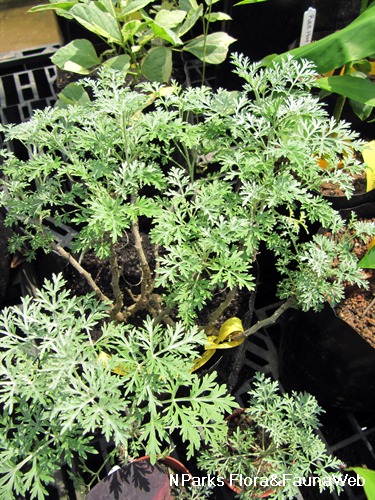
Back
Artemisia 'Powis Castle'
| Family Name: | Asteraceae (Compositae) |
| Common Name: | Wormwood 'Powis Castle' |
Name
Classifications and Characteristics
| Plant Division | Angiosperms (Flowering Seed Plants) (Dicotyledon) |
|---|---|
| Plant Growth Form | Shrub |
| Lifespan (in Singapore) | Perennial |
| Mode of Nutrition | Autotrophic |
| Plant Shape | Rounded, Shrubby |
Biogeography
| Native Habitat | Terrestrial |
|---|---|
| Local Conservation Status | Non-native |
Description and Ethnobotany
| Growth Form | A bushy woody shrub, it can grow up to 0.1 to 0.5 m in height. It has a rounded crown. |
|---|---|
| Foliage | The leaves are finely divided and silvery green. Emits fragrance when rubbed. |
| Stems | It has rhizomes which allows plants to grow up to 2 m wide if not restrained. |
| Flowers | Flowers are dull yellow, borne on narrow panicles. Flowers are rarely blooming. |
| Taxonomy | This plant is most likely a hybrid between Artemisia arborescens and Artemisia absinthium. |
| Cultivation | Requires well-drainage soil under full sun for plant to grow best. Plant does not survive well in moist to wet soil as it is susceptible to root rot. |
| Etymology | The genus Artemisia named after Artemis (Diana), wife of Mausolus, of Caria, Asia Minor. The cultivar was introduced in 1972 by the National Trust's Powis Castle, Wales. |
Landscaping Features
| Landscaping | It is grown for its interesting fern-like leaves that gives feathery appearance. |
|---|---|
| Desirable Plant Features | Ornamental Foliage, Fragrant (Foliage) |
| Landscape Uses | General, Parks & Gardens, Small Gardens, Flowerbed / Border |
| Thematic Landscaping | Silver Garden, Fragrant / Aromatherapy Garden |
Plant Care and Propagation
| Light Preference | Full Sun |
|---|---|
| Water Preference | Moderate Water, Little Water, [Remarks] (Does poorly in wet soil. ) |
| Plant Growth Rate | Fast |
| Rootzone Tolerance | Drought Tolerant, Well-Drained Soils |
| Pruning | Requires occasional pruning to keep the tidiness of plant. |
| Propagation Method | Seed, Stem Cutting (Herbaceous, Semi-Hardwood, Hardwood) |
Foliar
| Foliage Retention | Evergreen |
|---|---|
| Mature Foliage Colour(s) | Green, Silver / Grey |
| Foliar Arrangement Along Stem | Alternate |
| Foliar Attachment to Stem | Petiolate |
| Foliar Shape(s) | Non-Palm Foliage |
| Foliar Margin | Pinnately Lobed / Pinnatifid |
Floral (Angiosperm)
| Flower Colour(s) | Yellow / Golden |
|---|---|
| Flower Grouping | Cluster / Inflorescence |
| Inflorescence Type | Panicle |
Image Repository
Others
| Master ID | 31367 |
|---|---|
| Species ID | 5764 |
| Flora Disclaimer | The information in this website has been compiled from reliable sources, such as reference works on medicinal plants. It is not a substitute for medical advice or treatment and NParks does not purport to provide any medical advice. Readers should always consult his/her physician before using or consuming a plant for medicinal purposes. |





